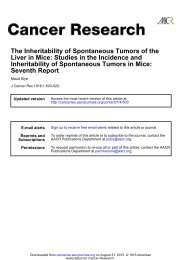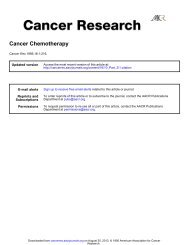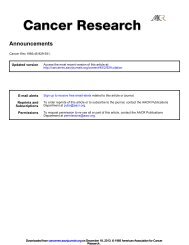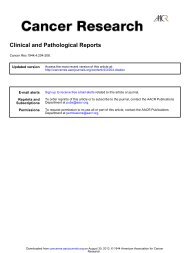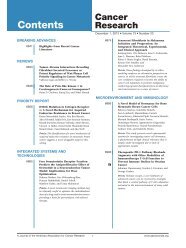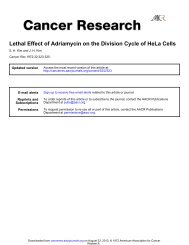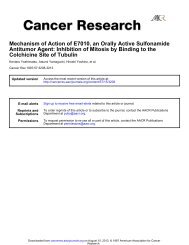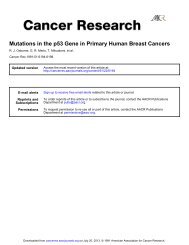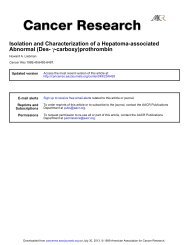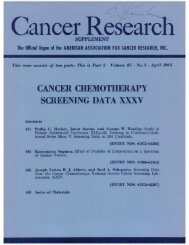Trichothiodystrophy, a Human DNA Repair ... - Cancer Research
Trichothiodystrophy, a Human DNA Repair ... - Cancer Research
Trichothiodystrophy, a Human DNA Repair ... - Cancer Research
You also want an ePaper? Increase the reach of your titles
YUMPU automatically turns print PDFs into web optimized ePapers that Google loves.
<strong>Trichothiodystrophy</strong>, a <strong>Human</strong> <strong>DNA</strong> <strong>Repair</strong> Disorder with<br />
Heterogeneity in the Cellular Response to Ultraviolet Light<br />
Alan R. Lehmann, Colin F. Arlett, Bernard C. Broughton, et al.<br />
<strong>Cancer</strong> Res 1988;48:6090-6096.<br />
Updated version<br />
Access the most recent version of this article at:<br />
http://cancerres.aacrjournals.org/content/48/21/6090<br />
E-mail alerts Sign up to receive free email-alerts related to this article or journal.<br />
Reprints and<br />
Subscriptions<br />
Permissions<br />
To order reprints of this article or to subscribe to the journal, contact the AACR Publications<br />
Department at pubs@aacr.org.<br />
To request permission to re-use all or part of this article, contact the AACR Publications<br />
Department at permissions@aacr.org.<br />
Downloaded from<br />
cancerres.aacrjournals.org on August 13, 2013. © 1988 American Association for <strong>Cancer</strong><br />
<strong>Research</strong>.
(CANCER RESEARCH 48, 6090-6096, November 1. 1988]<br />
<strong>Trichothiodystrophy</strong>, a <strong>Human</strong> <strong>DNA</strong> <strong>Repair</strong> Disorder with Heterogeneity in the<br />
Cellular Response to Ultraviolet Light1<br />
Alan R. Lehmann,2 Colin F. Arlett, Bernard C. Broughton, Susan A. Harcourt, Herdis Steingrimsdottir,<br />
Miria Stefanini, A. Malcolm R. Taylor, A. T. Natarajan, Stuart Green, Mary D. King, RoñaM. MacKie,<br />
John B. P. Stephenson, and John L. Tolmie<br />
MRC Cell Mutation Unit, University of Sussex, Fainter, Brighton, Sussex BNI 9RK, United Kingdom [A. R. L., C. F. A., B. C. B., S. A. H., H. S.J; Instituto di Genetica<br />
Biochimica ed Evoluzionistica C/VA, Via Abbiategrasso 207, 1-27100, Pavia, Italy [M. S.j; Department of <strong>Cancer</strong> Studies, Medical School, University of Birmingham,<br />
Birmingham BIS 2TJ, United Kingdom [A. M. R. T.J; Department of Radiation Genetics and Chemical Mutagenesis, University of Leiden, Wassenaarseweg 72,<br />
Leiden, The Netherlands [A. T. N.]; Royal Hospital for Sick Children, Yorkhill, Glasgow, United Kingdom [M. D. K., J. B. P. S.J; Department of Dermatology, University<br />
of Glasgow, 56 Dumbarton Road, Glasgow GII 6NU, United Kingdom fR. M. M.J; Institute of Child Health, Birmingham University, Francis Road, Birmingham BI6<br />
SET, United Kingdom fS. G.J; Duncan Guthrie Institute of Medical Genetics, Yorkhill, Glasgow G3 SSJ, United Kingdom fJ. L. T.J<br />
ABSTRACT<br />
<strong>Trichothiodystrophy</strong> (I'll)) is an autosomal recessive disorder char<br />
acterized by brittle hair with reduced sulfur content, ichthyosis, peculiar<br />
face, and mental and physical retardation. Some patients are photosen<br />
sitive. A previous study by Stefanini et al. (Hum. Genet., 74: 107-112,<br />
1986) showed that cells from four photosensitive patients with I'll) had<br />
a molecular defect in <strong>DNA</strong> repair, which was not complemented by cells<br />
from xeroderma pigmentosum, complementation group D. In a detailed<br />
molecular and cellular study of the effects of UV light on cells cultured<br />
from three further I'll) patients who did not exhibit photosensitivity we<br />
have found an array of different responses. In cells from the first patient,<br />
survival, excision repair, and <strong>DNA</strong> and RNA synthesis following UV<br />
irradiation were all normal, whereas in cells from the second patient all<br />
these responses were similar to those of excision-defective xeroderma<br />
pigmentosum (group D) cells. With the third patient, cell survival meas<br />
ured by colony-forming ability was normal following UV irradiation, even<br />
though repair synthesis was only 50% of normal and RNA synthesis was<br />
severely reduced. The excision-repair defect in these cells was not com<br />
plemented by other I'll) cell strains. These cellular characteristics of<br />
patient 3 have not been described previously for any other cell line. The<br />
normal survival may be attributed to the finding that the deficiency in<br />
excision-repair is i-imfmed to early times after irradiation. Our results<br />
pose a number of questions about the relationship between the molecular<br />
defect in <strong>DNA</strong> repair and the clinical symptoms of xeroderma pigmen<br />
tosum and I'll).<br />
INTRODUCTION<br />
<strong>Trichothiodystrophy</strong> is an autosomal recessive disorder char<br />
acterized by sulfur-deficient brittle hair. Hair shafts split lon<br />
gitudinally into small fibers and this brittleness is associated<br />
with levels of cysteine/cystine in hair proteins which are 15-<br />
50% of those in normal individuals (1-3). The condition is also<br />
accompanied by physical and mental retardation of varying<br />
seventy (1, 3-6). The patients often have an unusual facial<br />
appearance, with protruding ears and a receding chin. Mental<br />
abilities range from low normal to severe retardation. Ichthyosis<br />
(scaling of the skin) has been reported in many of the affected<br />
patients (3, 6-8). The disorder was first recognized by Pollitt<br />
et al. ( l ) and about 20 reports of similar cases have appeared<br />
in the literature. The accompanying symptoms are very heter<br />
ogeneous. Severe photosensitivity has been reported for about<br />
one-half of the patients (e.g., Refs. 3, 7, and 9). Skin cancer has<br />
not been reported in any patient with TTD.3 The condition has<br />
Received 5/3/88: revised 7/25/88; accepted 7/29/88.<br />
The costs of publication of this article were defrayed in part by the payment<br />
of page charges. This article must therefore be hereby marked advertisement in<br />
accordance with 18 U.S.C. Section 1734 solely to indicate this fact.<br />
' This work was supported in part by EC Contracts BI6.042.UK(H) and<br />
BI6.I58.I.<br />
1To whom requests for reprints should be addressed.<br />
1The abbreviations used are: TTD, trichothiodystrophy; CS, Cockayne's syn<br />
drome; SCE, sister chromatid exchange; UDS, unscheduled <strong>DNA</strong> synthesis; XP,<br />
xeroderma pigmentosum.<br />
been reviewed recently by Nuzzo and Stefanini (10).<br />
The association of TTD with a <strong>DNA</strong> repair defect was first<br />
reported briefly by Yong et al. (9) and van Neste et al. (11).<br />
These reports both stated that in cells from photosensitive<br />
patients with TTD there was a defect in excision repair follow<br />
ing UV damage, similar to that observed in patients with<br />
xeroderma pigmentosum. A more extensive study by Stefanini<br />
et al. (7) showed that four Italian patients with TTD and<br />
associated photosensitivity all showed a deficiency in excisionrepair<br />
of UV damage in both lymphocytes and fibroblasts.<br />
Furthermore, cell fusion studies with cells from different XP<br />
complementation groups showed that there was no complemen<br />
tation between TTD cells and those from XP group D. In<br />
contrast an Italian TTD patient without photosensitivity had<br />
no defect in excision-repair (12).<br />
We have carried out a detailed study of the response to UV<br />
light of fibroblasts from three further patients with TTD, and<br />
our results, which show remarkable heterogeneity between pa<br />
tients, are presented in this paper. We find that the cells from<br />
one patient have a completely normal response to UV, whereas<br />
those from a second patient show characteristics of XP-D cells,<br />
like those described by Stefanini et al. (7). The cells from the<br />
third patient show some normal responses, whereas other as<br />
pects are markedly deficient depending on the nature of the<br />
assay.<br />
MATERIALS AND METHODS<br />
Patients. Two of the TTD patients whose cells are used in our<br />
experiments are those described by King et al. (6). Réévaluation of the<br />
clinical data on these patients has revealed that, contrary to previous<br />
suggestions (6), neither of them exhibited any photosensitivity. Cultures<br />
from these patients are correctly designated TTD1GL and TTD2GL,<br />
respectively, but we shall refer to them in this paper, for simplicity, as<br />
PI and P2.<br />
The third strain, TTD1BI (referred to as P3), was from a 6-year-old<br />
boy with brittle hair and trichorrhexis nodosa. His height is 86.5 cm<br />
and weight is 10.7 kg (both below the 3rd percentile), his head circum<br />
ference is 47 cm (also below 3rd percentile). He has a thin face, full<br />
cheeks, stubbly hair and nystagmus with remnants of cataracts which<br />
were removed at 3 months of age. His nails are dysplastic and his skin<br />
is ichthyotic. There are no indications of photosensitivity. Although he<br />
is able to smile, socialize, laugh, and chuckle, he has no real language.<br />
He sits, stands, and manipulates simple toys but does not walk unaided.<br />
At birth he had the characteristic "collodion baby" appearance of the<br />
skin, and he had a slightly abnormal facial appearance with brittle<br />
stubbly hair. In infancy he had many respiratory infections and did not<br />
thrive well, and at age 2 years 10 months he had an attack of severe<br />
abdominal pain for which no cause was found. An attack of measles at<br />
age 4 years was followed by general debility and according to his mother<br />
a regression of development. Progress thereafter has been slow, but he<br />
appears to be stable with no further degeneration.<br />
6090<br />
Downloaded from<br />
cancerres.aacrjournals.org on August 13, 2013. © 1988 American Association for <strong>Cancer</strong><br />
<strong>Research</strong>.
Cell Culture. The fibroblasl cell strains used in our experiments were<br />
all established from skin biopsies in our own or other laboratories.<br />
They are listed in Table 1. Cells were maintained in Eagle's minimum<br />
essential medium supplemented with 15% fetal calf serum. To bring<br />
them into a state approaching quiescence, they were plated in complete<br />
medium, which was replaced the following day with medium containing<br />
0.5% serum. The cells were then incubated for at least 2 days prior to<br />
experiments. Although not all of the population will have completely<br />
ceased dividing after 2 days, for brevity we refer to such populations as<br />
nondividing.<br />
Cellular Responses to UV. Procedures for cell culture (13), cell<br />
survival (14), mutation (15). UDS(16), recovery of RNA synthesis (17,<br />
18), stationary phase survival (17), and complementation (12) following<br />
UV irradiation are routinely used in our laboratories and have all been<br />
described previously. For determination of SCEs exponentially growing<br />
cells were UV irradiated and cultured for two cycles (44-50 h) in the<br />
presence of 5 JJM bromodeoxyuridine. The cells were processed as<br />
described previously (19). Measurement of repair replication using<br />
alkaline CsCI gradients followed the procedure of Smith and Hanawalt<br />
(20). UV endonuclease-sensitive sites were assayed in permeabilized<br />
cells by the high-salt procedure of van Zeeland et al. (21). For measure<br />
ment of incision breaks 2 x 105normal cells and TTD cells were labeled<br />
with 0.05 nCi/ml ['"qthymidine (50 mCi/mmol) and 5 ¿iCi/ml['Hj-<br />
<strong>DNA</strong> REPAIR DEFECT IN TRICHOTHIODYSTROPHY<br />
thymidine (2.5 Ci/mmol), respectively. The following day the medium<br />
was replaced with fresh medium containing 0.5% fetal calf serum. After<br />
a further 2 or 3 days of incubation, the cells were incubated for 30 min<br />
in 0.5% serum medium containing 10~2M hydroxyurea. IO"4M \-ß-o-<br />
arabinofuranosylcytosine, UV irradiated, and incubated for a further<br />
30 min in the presence of the inhibitors. Cells were then scraped off<br />
the dishes into 0.2 ml 0.02% EDTA in buffered saline, the "C-labeled<br />
normal cell suspension was mixed with the 3H-labeled TTD cell sus<br />
pension which had been exposed to the same treatment, and 150 ^1<br />
were lysed on top of alkaline sucrose gradients which were subsequently<br />
centrifuged at 30,000 rpm for 60 min. Fractions were collected and the<br />
radioactivity measured as described previously (22).<br />
RESULTS<br />
We have examined the responses of TTD cells to UV irradi<br />
ation using several different assay systems.<br />
Patient 1. The responses to UV light of cell strain PI were<br />
normal in all assays in which they were tested, as shown by the<br />
filled inverted triangles in the figures. Thus cell survival (Fig.<br />
1), mutability (Fig. 2A), and SCE induction (Fig. 2B) were all<br />
similar to those in normal cells. The spontaneous and induced<br />
usedPhenotype<br />
strainsNormal<br />
Table 1 Cell strains<br />
Cell<br />
IBRGM73048BRVHKBSBTTD<br />
TTDIGL(PI)TTD2GL<br />
(P2)TTD3BI<br />
(P3)TTD3PVTTD4PVCS<br />
CS1BOCS1BRCS2BEXP<br />
XPIBR (D)°XP5BRXP2BI<br />
(G)XP2RO<br />
(E)XP9PV<br />
(C)XP25RO<br />
(A)XP4LO<br />
(A)Ref.667742164344454414"<br />
Letters in parentheses, complementation groups.<br />
l 23456<br />
UV.DOSE Um2!<br />
o IBR<br />
T PI<br />
P2<br />
•P3<br />
A TTD4PV<br />
O CSBO<br />
n CS1BR<br />
XPIBR<br />
A XP5BR<br />
V XP2BI<br />
Fig. 1. Cell survival in TTD cells. Colony-forming ability of growing cells UV<br />
irradiated with different fluences.<br />
UVDOSE[J.m2]<br />
01 23456<br />
n—<br />
0.5 1.0 1.5<br />
UV DOSEUrn*]<br />
O VH (ñor-mal)<br />
TP1<br />
P2<br />
•P3<br />
AXP1BR<br />
BXP4LO<br />
Fig. 2. Mutation and SCEs. A. induction by U V of mutations to 6-thioguanine<br />
resistance in various cell strains. Shaded area, range of responses of normal cells<br />
from data accumulated over a period of many years. B, induction of SCEs by UV<br />
light. For each experimental point, 25 cells were scored.<br />
mutation frequencies of PI appear from Fig. 2A to be lower<br />
than those of normal cells. The scale of these experiments is<br />
such that we did not consider confirmation and more detailed<br />
investigation of this observation to be warranted at this time.<br />
The only conclusion we wish to draw from the data is that PI<br />
cells are clearly not more mutable than normals.<br />
Biochemical measurements showed that unscheduled <strong>DNA</strong><br />
synthesis was very similar to that in normal cells (Fig. 3-4), as<br />
was the recovery of RNA synthesis following UV irradiation<br />
(Fig. 4A).<br />
Patient 2. The responses of strain P2 were, in contrast, those<br />
of cells with a severe deficiency in excision-repair (see filled<br />
circles in the figures). The survival of P2 was much lower than<br />
6091<br />
Downloaded from<br />
cancerres.aacrjournals.org on August 13, 2013. © 1988 American Association for <strong>Cancer</strong><br />
<strong>Research</strong>.
O 25<br />
UVDOSEtJ/ri2]<br />
100<br />
10 0 2.5<br />
UVDOSElJrn2]<br />
Fig. 3. <strong>Repair</strong> synthesis in TTD cells. A, scintillation counting. Nondividing<br />
cells were UV irradiated and labeled with 10 /iCi/ml [3H]thymidine for 2 h in the<br />
presence of 10 mM hydroxyurea. The radioactivity incorporated into unirradiated<br />
cells (usually about 1 cpm/100 cells) was subtracted from that in irradiated cells.<br />
Results show means ±SEM (bars) of 3-6 experiments for all cell lines except P2<br />
(single experiment). B, autoradiography. C equilibrium centrifugaron. Following<br />
UV irradiation confluent cultures of "P-labeled cells were labeled for 3 h with 10<br />
^Ci/ml ['H]thymidine in the presence of 10~5M bromodeoxyuridine and 10~*M<br />
fluorodeoxyuridine. and the <strong>DNA</strong> was extracted and centrifuged to equilibrium<br />
in alkaline CsCl gradients. Ordinate, specific activity of the 'H label associated<br />
with normal density <strong>DNA</strong>. The results from one of three experiments is shown.<br />
In D the same experiment was carried out but with exponentially growing cells.<br />
Normals 123 CS XP 0 20<br />
UV DOSEUm'<br />
Fig. 4. RNA synthesis after UV irradiation. A, nondividing cells were UV<br />
irradiated (15 J/m2) and 16 h later they were pulse labeled with ['H|uridine for 1<br />
h. Results are expressed as a percentage of incorporation compared to that in<br />
unirradiated cells. Bars, SEM. B. dose response for RNA synthesis.<br />
that of normal cells, its response being similar to that of cells<br />
from patients with XP or Cockayne's syndrome and of a strain<br />
<strong>DNA</strong> REPAIR DEFECT IN TR1CHOTH1ODYSTROPHY<br />
TTD4PV from an Italian patient previously described by Ste<br />
fanini et al. (7) (Fig. 1). Likewise the mutability of P2 cells to<br />
6-thioguanine resistance was greatly enhanced like that of XP<br />
cells (Fig. 2A). Furthermore more SCEs were induced in P2<br />
(Fig. 28), as has previously been shown for excision-defective<br />
XP cells (23). These cellular abnormalities could be attributed<br />
to a deficiency in excision-repair, as shown by a reduced rate of<br />
removal of UV-induced damage, measured as endonucleasesensitive<br />
sites (Fig. 5), and a low rate of UDS as shown in Fig.<br />
3/4. The reduced survival and UDS in P2 are properties similar<br />
6092<br />
OC<br />
to those of cell strains from four photosensitive Italian TTD<br />
patients (7).<br />
The deficiency in UDS forms the basis of a genetic comple<br />
mentation test for XP, and it has been used to reveal nine<br />
different complementation groups. In these studies cells from<br />
different XPs were fused and UDS was measured in the result<br />
ing heterokaryons. Restoration of UDS to levels found in<br />
normal cells indicates that the two donor cells are in different<br />
complementation groups. Conversely, if UDS remains at the<br />
reduced levels of the donor cells the two donors are assigned to<br />
the same complementation group. Previous work (7) showed<br />
that four TTD strains failed to complement XPs from comple<br />
mentation group D. Results shown in Table 2 show that P2 did<br />
not complement two of these previously studied TTD strains,<br />
TTD3PV and TTD4PV. UDS in the heterokaryons remained<br />
at the same level as in the parental cells. In contrast, when<br />
these strains were fused with an XP strain from complementa<br />
tion group C (XP9PV), UDS in the heterokaryons was restored<br />
to normal levels. In contrast, in heterokaryons from PI and<br />
TTD3PV or TTD4PV, UDS was restored to normal levels.<br />
Thus PI cells, unlike P2 cells, are able to correct the defect in<br />
TTD3PV and TTD4PV.<br />
The genetic disorder Cockayne's syndrome is, like XP, UV<br />
sensitive at the cellular level but, in contrast to XP, shows no<br />
obvious deficiency in excision-repair (24). Nevertheless in CS<br />
cells RNA synthesis fails to recover following its depression by<br />
UV irradiation, whereas in normal cells rapid recovery occurs<br />
to normal levels (17). Observation of this deficiency in CS cells<br />
can be optimized by using nondividing cells and measuring<br />
RNA synthesis 16-24 h after irradiation with a high UV fluence<br />
(25). Fig. 4A shows that under these conditions, as reported<br />
previously, RNA synthesis in XP and CS cells was reduced to<br />
very low levels whereas in normal cells it had recovered almost<br />
to unirradiated levels. In contrast to the normal response of PI,<br />
RNA synthesis was reduced to 10% of unirradiated levels in<br />
P2.<br />
Patient 3. The cellular responses of P3 (filled squares in<br />
figures) to the lethal (Fig. 1), mutagenic (Fig. 2A), and SCEinducing<br />
(Fig. IB) effects of UV irradiation were, as with PI,<br />
indistinguishable from those of normal cells. Likewise the rate<br />
of removal of UV endonuclease-sensitive sites in normal and<br />
P3 cells were the same (Fig. 5). In marked contrast, however,<br />
measurements of UDS revealed a clear deficiency in P3, partie-<br />
Table2 Complementation ofTTDcells<br />
Cultures of two parental cell strains, a and b. labeled with latex beads of<br />
different sizes, were fused, incubated for 48 h at 37"C, UV irradiated (20 J/m1),<br />
and incubated for 3 h with [3H]thymidine. Autoradiography was performed and<br />
the number of grains over the nuclei in 50 mononuclear parental cells and in 25<br />
heterokaryons was counted (12).<br />
Fusion partners<br />
(axb)Experiment<br />
1P2<br />
TTD3PVP2 x<br />
TTD4PVP2 x<br />
XP9PVPI X<br />
TTD3PVPI x<br />
TTD4PVPI X<br />
XP9PVExperiment<br />
X<br />
2P3<br />
TTD3PVP3 x<br />
TTD4PVExperiment<br />
x<br />
3P3<br />
XP9PVP3 x<br />
x XP25ROa12.4<br />
1.49.8 ±<br />
0.812.4± ±<br />
1.178.5<br />
2.971.2 ±<br />
±2.475.6<br />
2.029.7 ±<br />
0.430.9 +<br />
0.930.9 ±<br />
Grains/nucleus ±SEM<br />
Parental cells<br />
1.412.8 ±<br />
0.81 +<br />
0.79.4 3.4 ±<br />
0.814.8 ±<br />
±0.615.1<br />
1.07.4 ±<br />
0.311.4 ±<br />
±0.412.7<br />
±0.912.5+<br />
1.159.7<br />
1.271.2 ±<br />
±2.664.9<br />
1.274.4 ±<br />
2.029.2 ±<br />
0.930.5 ±<br />
0.471.1 ±<br />
1.534.0 ± 0.55.1 + 3.469.3 ±<br />
±2.6b13.4 ±0.5Heterokaryons12.9 ±4.9<br />
Downloaded from<br />
cancerres.aacrjournals.org on August 13, 2013. © 1988 American Association for <strong>Cancer</strong><br />
<strong>Research</strong>.
CT.100<br />
E 60<br />
20<br />
O NORMAL<br />
•P2<br />
•P3<br />
036 24<br />
TIMEth]<br />
<strong>DNA</strong> REPAIR DEFECT IN TRICHOTHIODYSTROPHY<br />
Fig. 5. Removal of UV endonuclease-sensitive sites. Cells were incubated for<br />
various times after UV irradiation with 4 J/m2. Normal cells labeled with<br />
[MC]thymidine (0.05 fiCi/ml) mixed with TTD cells labeled with [3H]thymidine<br />
(5 >iCi/ml) were permeabilized and incubated with a crude fraction ofMicrococcus<br />
luteus extract containing UV endonuclease activity. The mixture was lysed on top<br />
of alkaline sucrose gradients. The number of breaks (UV endonuclease-sensilive<br />
sites) was calculated from weight-average molecular weights of the molecular<br />
weight distribution of the <strong>DNA</strong> molecules. Bars, SEM.<br />
ularly at higher doses, the level after 10 J/m2 being some 40%<br />
of that in normal cells (Fig. 3.4). The repair synthesis step of<br />
the excision-repair process can be measured in several different<br />
ways. The results in Fig. 3A were obtained by measurement of<br />
incorporation of [3H]thymidine into UV-irradiated cells the<br />
semiconservative <strong>DNA</strong> replication of which had been inhibited<br />
by hydroxyurea (16). This experimental procedure was devel<br />
oped for rapidity, but it is not completely rigorous (see Ref.<br />
16). We have therefore also measured repair synthesis in normal<br />
and P3 cells by autoradiography (Fig. ÃŒB) and by equilibrium<br />
centrifugation in alkaline CsCl gradients (Fig. 3C). The results<br />
using all three procedures were similar and demonstrated a<br />
clear deficiency in excision-repair in P3 despite its normal<br />
survival.<br />
The deficiency in UDS in P3 enabled complementation tests<br />
to be carried out, and the results in Table 2 show that P3, like<br />
P2, failed to complement the Italian TTD cell strains, whereas<br />
they did complement XPs from complementation groups C<br />
(XP9PV) and A (XP25RO).<br />
The discrepancy between the normal responses of P3 cells<br />
shown in Figs. 1, 2, and 5 and the defective repair synthesis<br />
shown in Fig. 3 prompted us to carry out a more detailed<br />
examination of excision-repair in P3 cells.<br />
Kinetics of Excision-<strong>Repair</strong>. The rate of the incision step of<br />
excision-repair can be measured by inhibiting the repair synthe<br />
sis step with a combined treatment of hydroxyurea and 1-0-Darabinofuranosylcytosine<br />
and then measuring the accumulation<br />
of incision breaks in the <strong>DNA</strong> (26). The dose responses for the<br />
number of breaks accumulated in 30 min following UV irradi<br />
ation (Fig. 6) were very similar to those obtained in the repair<br />
synthesis experiments (Fig. 3). Breaks were barely detectable in<br />
strain P2, and in P3 they were reduced to about 50% of that in<br />
normal cell strains.<br />
The UDS and incision break experiments in which a defi<br />
ciency in P3 cells was revealed differed from the cellular exper<br />
iments and the UV endonuclease assay in two respects. The<br />
former assays were carried out over a short period of time<br />
immediately after UV irradiation, and they used nondividing<br />
cells, whereas the latter were long-term measurements using<br />
dividing cells. In order to ascertain whether these differences in<br />
conditions could account for the apparent discrepancies in our<br />
observations we have measured repair replication in dividing<br />
cells and extended our measurements over a period of 24 h.<br />
Fig. 3D shows the dose response for repair replication in<br />
dividing cells over a 3-h period. The results are similar to those<br />
6093<br />
'O<br />
01234<br />
•48BR Inormals<br />
e GM730I<br />
•P2<br />
•P3<br />
UYDOSElOrtfl<br />
Fig. 6. Incision breaks. Nondividing cells were incubated for 30 min in the<br />
presence of hydroxyurea and l-#-D-arabinofuranosylcytosine following UV irra<br />
diation with different doses. The weight-average molecular weights of the <strong>DNA</strong><br />
molecules were calculated after centrifugation in alkaline sucrose gradients, and<br />
the number of breaks was determined.<br />
CC 3<br />
UJ<br />
u.<br />
ü2<br />
"-> 1<br />
o GM 730<br />
•P3<br />
6 12<br />
T i m e (h)<br />
Fig. 7. Time course of repair replication. "P-labeled exponentially growing<br />
cells were UV irradiated with a fluence of 10 J/m2 and incubated for various<br />
times in the presence of hydroxyurea, |3H]thymidine, and bromodeoxyuridine.<br />
The specific activity of the repaired<br />
alkaline CsCl gradients.<br />
<strong>DNA</strong> was measured by centrifugation in<br />
Table 3 <strong>Repair</strong> replication at different times after L'y irradiation<br />
12P-Labeled dividing cells were UV irradiated (10 J/m2) and incubated with<br />
[3H)thymidine and bromodeoxyuridine for the time intervals shown. The <strong>DNA</strong><br />
was centrifuged in alkaline CsCl gradients. The relative specific activity of the II<br />
to the
esponse curve in Fig. 4B again shows, however, that this failure<br />
to recovery to normal rates is observed only at fluences above<br />
5 J/m2. In contrast in P2 cells a drastic depression of RNA<br />
synthesis is observed after 5 J/m2.<br />
We have also measured cell survival in P3 cells by a procedure<br />
in which nondividing cells are irradiated (27). Dead cells detach<br />
from the dishes after a few days, and the living cells which<br />
continue to adhere are scored. Using this procedure we found<br />
that under these conditions nondividing P3 cells were indeed<br />
more sensitive to the killing action of LJV than were normal<br />
cells (Fig. 8). Note that the lowest UV fluence used in this<br />
procedure is 10 J/m2.<br />
DISCUSSION<br />
The UV responses of our three TTD cell strains are compared<br />
with those of XP and CS strains in Table 4. PI was normal in<br />
all respects whereas the responses of P2 were identical to those<br />
of XP cells from complementation group D. P3 also had a<br />
deficiency in excision-repair which was not complemented by<br />
other excision-deficient TTD cell strains. This deficiency was<br />
less severe than in P2 cells, and dividing P3 cells were not in<br />
fact hypersensitive to either the lethal, mutagenic, or SCEproducing<br />
effects of UV light (Figs. 1 and 2). Our results pose<br />
a number of important questions about the relationship of<br />
defects in <strong>DNA</strong> repair to cell survival, the heterogeneity of the<br />
response of TTD cells, and the relationship between TTD and<br />
XP.<br />
<strong>DNA</strong> <strong>Repair</strong> and Cell Survival: The Anomalous Response of<br />
P3. The cellular responses to UV of P3 are, as far as we are<br />
aware, unique. The molecular defect is not complemented by<br />
other TTD strains, which in turn were not complemented by<br />
0 10 20 30<br />
U.V.DOSE Qrrtf]<br />
Fig. 8. Survival of nondividing cultures. Nondividing cells, maintained for 7<br />
days in medium containing 0.5^'c serum, were UV irradiated with various fluences.<br />
After a further 7 days the cells adhering to the dishes were trypsinized and<br />
counted.<br />
Table 4 Summary of UV responses in TTD cells'<br />
Survival (CFA)Survival<br />
(ND)MutabilitySCEsUDSScintAutoradiographyEq.<br />
<strong>DNA</strong> REPAIR DEFECT IN TRICHOTHIODYSTROPHY<br />
XP-D cell strains (7). The simplest interpretation of these<br />
complementation data is that the TTD and XP-D strains have<br />
defects in the same gene, although this remains unproved, and<br />
other interpretations are possible. The level of UDS in XP-D<br />
cell lines is generally between 10 and 50% of that in normal<br />
cells (14, 16, 28-30), so that P3 is at the higher end of this<br />
spectrum. However, all XP-D strains examined show extreme<br />
hypersensitivity to the lethal effects of UV with D0 values being<br />
between 3- and 10-fold less than that of normal strains (Refs.<br />
30-32 and our own unpublished results). In contrast dividing<br />
P3 cells were not hypersensitive to UV light. We have shown<br />
that the molecular defect in P3 is most marked after high UV<br />
fluences and during the period immediately following irradia<br />
tion. It is possible that sufficient repair occurs at later times to<br />
bring about normal survival, mutability, and SCEs after rela<br />
tively low UV fluences in dividing cells. After high UV fluences<br />
in nondividing cells, however, RNA synthesis fails to recover<br />
and cells are killed.<br />
What is the nature of the deficiency in excision-repair at<br />
early times after UV irradiation of P3 cells? The amount of<br />
repair synthesis measured in experiments such as those shown<br />
in Fig. 3 is the product of the number of repaired sites and the<br />
size of the repaired patch of <strong>DNA</strong> at each site. Decreased repair<br />
synthesis could result either from fewer repaired sites or from<br />
shorter repair patches. We consider that in P3 cells the former<br />
explanation is much more likely since the dose response for<br />
repair synthesis (Fig. 3) is very similar to that for incision<br />
breaks (Fig. 6). The latter parameter is not affected by the size<br />
of the repaired patch. Two excision-repair processes are known<br />
to occur early after UV irradiation. <strong>Repair</strong> of pyrimidine dimers<br />
in actively transcribing regions of <strong>DNA</strong> occurs rapidly (33), and<br />
recent work has shown that CS cells are specifically deficient<br />
in this repair process (34). As shown in Table 4, however, CS<br />
cells differ from P3 cells in having no detectable defect in<br />
overall excision-repair (24) (the defect can be observed only by<br />
studying specific genes) and CS cells are hypersensitive to the<br />
lethal, mutagenic, and SCE-producing effects of UV light.<br />
Excision of 6-4 photoproducts has also been shown to occur<br />
rapidly after irradiation (35), and it is not inconceivable that<br />
P3 cells, like XP cells from various complementation groups<br />
including group D (36), are deficient in removal of these lesions<br />
from cellular <strong>DNA</strong>. Experiments are under way to test this<br />
hypothesis. In the meantime a definitive explanation for the<br />
normal cellular properties of P3 being associated with deficient<br />
excision-repair must await further experimentation.<br />
Heterogeneity of TTD. Although the clinical symptoms of<br />
TTD are diverse, they form a defined syndrome. Our results at<br />
the cellular level emphasize this heterogeneity. At the two<br />
extremes we have PI, which like a TTD cell strain described by<br />
Stefanini et al. (12) has no cellular defect in its responses to<br />
UV light, and P2 and several TTD strains of Stefanini et al. (1)<br />
with extreme hypersensitivity and very defective excision repair<br />
attributable to the "XP-D mutation." In between is P3 with<br />
some defective responses and others normal. It is of interest<br />
that none of our patients exhibited any photosensitivity. In the<br />
Italian patients defective excision-repair correlated with pho<br />
tosensitivity.<br />
Cent.Incision<br />
XP and TTD. An intriguing implication of the findings of<br />
breaksUV<br />
endonucleaseRNA<br />
Stefanini et al. (7, 12) and of those described in this report<br />
synthesisPINNN100100NP2SSSSs1015SSsSSP3NSNN505050SNSSXPDSSSSSSSS10-5010-5010-50SSSSSCSSSSSSSSS100100100NNSS<br />
concerns the relationship between the defect in <strong>DNA</strong> repair<br />
°Data from XP-D and CS strains are from the literature. N. normal; S, and the clinical symptoms of XP and TTD (also discussed in<br />
sensitive or defective; SS, very sensitive or defective. UDS values are expressed<br />
as approximate percentages of values in normal strains. CFA, Colony-forming<br />
ability; ND. Nondividing cells; Scint., scintillation counting: Eq. Cent., equilib<br />
rium centrifugation.<br />
Ref. 10). The extensive literature on XP has established, almost<br />
as a dogma, that a defect in excision-repair is the underlying<br />
cause of most of the skin lesions, especially of the enhanced<br />
6094<br />
Downloaded from<br />
cancerres.aacrjournals.org on August 13, 2013. © 1988 American Association for <strong>Cancer</strong><br />
<strong>Research</strong>.
frequency of carcinoma and melanoma associated with the<br />
disease. The clinical symptoms of XP may result from a com<br />
bination of an enhanced frequency of somatic mutations (e.g..<br />
Ref. 37) and a possible depression of the immune response<br />
following solar exposure of XP patients (38, 39), although the<br />
immunodeficiency is controversial. The implication of this is<br />
that any individual with an XP-like defect in excision-repair<br />
would be expected to exhibit the clinical symptoms of XP. In<br />
the excision-defective TTD patients such as P2 this is mani<br />
festly not the case. The skin symptoms of TTD are quite<br />
different from those of patients with XP group D, and there<br />
are no reports of skin cancer associated with TTD (although<br />
skin cancers are not particularly frequent in young patients<br />
from XP group D; e.g., see Refs. 29 and 30). Conversely XP<br />
patients do not show the sulfur-deficient brittle hair, the ichthyosis,<br />
the short stature or the peculiar facies associated with<br />
TTD. An explanation that the mutation causing one of the<br />
diseases is a deletion extending into the gene responsible for<br />
the other disorder is not consistent with these differences in the<br />
clinical symptoms. If one of the disorders (e.g., TTD) resulted<br />
from a deletion which extended into the XP-D gene, the symp<br />
toms of TTD would be expected to include all the symptoms<br />
of XP. Furthermore cytogenetic analysis has failed to detect<br />
any abnormalities in cells from three TTD patients (40).<br />
TTD and XP-D may therefore be phenotypes of patients with<br />
different defects in the same gene. Very diverse clinical symp<br />
toms resulting from different mutations in the globin genes<br />
have been widely reported for the thalassemias (e.g., see Ref.<br />
41). The eventual cloning of the genes defective in XP-D and<br />
TTD and analysis of the mutations resulting in the two disor<br />
ders should help to unravel the relationships between them.<br />
ACKNOWLEDGMENTS<br />
We are grateful to Dr. Christine Smalley, Selly Oak Hospital, Bir<br />
mingham, for referring patient P3 to us.<br />
REFERENCES<br />
1. Pollitt, R. J., Fenner, F. A., and Davies. M. Sibs with mental and physical<br />
retardation and trichorrhexis nodosa with abnormal amino acid composition<br />
of the hair. Arch. Dis. Child., 43: 211-216. 1968.<br />
2. Baden. H. P., Jackson. C. E.. Weiss. L.. Jimbow. K.. Lee. L.. Kubilus. J..<br />
and Gold, R. J. M. The physicochemical properties of hair in the BIDS<br />
syndrome. Am. J. Hum. Genet., 27: 514-521, 1976.<br />
3. Price, V. H.. Odom. R. B.. Ward, W. H., and Jones. F. T. <strong>Trichothiodystrophy</strong>.<br />
Sulfur-deficient brittle hair as a marker for a neuroectodermal symptom<br />
complex. Arch. Dermatol., 116: 1375-1384, 1980.<br />
4. Jackson. C. E., Weiss, C., and Watson, J. H. L. "Brittle" hair with short<br />
stature: intellectual impairment and decreased fertility: an autosomal reces<br />
sive syndrome in an Amish kindred. Pediatrics. 54: 201-208, 1974.<br />
5. Coulter, D. L.. Beals. T. F.. and Allen. R. J. Neurotrichosis: hair-shaft<br />
abnormalities associated with neurological diseases. Dev. Med. Child. Neurol.<br />
24:634-644. 1982.<br />
6. King. M. D., Gummer, C. L.. and Stephenson, J. B. P. <strong>Trichothiodystrophy</strong>neurotrichocutaneous<br />
syndrome of Pollitt: a report of tuo unrelated cases. J.<br />
Med. Genet.. 21: 286-289. 1984.<br />
7. Stefanini. M., Lagomarsini. P., Arieti, C. F., Marinoni. S., Burrone, C.,<br />
Crovato, F., Trevisan. G., Cordone. G.. and Nuzzo, F. Xeroderma pigmentosum<br />
(complementation group D) mutation is present in patients affected<br />
by trichothiodystrophy with photosensitivity. Hum. Genet.. 74: 107-112.<br />
1986.<br />
8. Jorizzo, J. L., Atherton. D. J., Crounse. R. G.. and Wells. R. S. Ichthyosis.<br />
brittle hair, impaired intelligence, decreased fertility and short stature (IBIDS<br />
syndrome). Br. J. Dermatol., 106: 705-710. 1982.<br />
9. Yong, S. L., Cleaver, J. E., TullÃs,G. D., and Johnston, M. M. Is trichothio<br />
dystrophy part of the xeroderma pigmentosum spectrum? Clin. Genet., 36:<br />
82S, 1984.<br />
10. Nuzzo, F.. and Stefanini, M. The association of xeroderma pigmentosum<br />
with trichothiodystrophy: a clue to a better understanding of XP-D? in: A.<br />
Castellani (ed.), <strong>DNA</strong> Damage and <strong>Repair</strong>. New York: Plenum Publishing<br />
Co.. in press. 1988.<br />
11. Van Neste, D.. Caulier. B.. Thomas. P.. and Vasseur. F. PIBIDS: Tay's<br />
<strong>DNA</strong> REPAIR DEFECT IN TRICHOTHIODYSTROPHY<br />
6095<br />
12<br />
13.<br />
14.<br />
15.<br />
16.<br />
17.<br />
18.<br />
19.<br />
20.<br />
21.<br />
22.<br />
23.<br />
24.<br />
25.<br />
26.<br />
27.<br />
28.<br />
29.<br />
30.<br />
31.<br />
32.<br />
33.<br />
34.<br />
35.<br />
36.<br />
37.<br />
syndrome and xeroderma pigmentosum. J. Am. Acad. Dermatol.. 12: 372-<br />
373. 1985.<br />
Stefanini. M.. Lagomarsini. P.. Giorgi, R.. and Nuzzo, F. Complementation<br />
studies in cells from patients affected by trichothiodystrophy with normal or<br />
enhanced photosensitivity. Mutât.Res.. 191: 117-119. 1987.<br />
Cole. J.. and Arieti. C. F. The detection of gene mutations in cultured<br />
mammalian cells./n:S. Venittand J. M. Parry (eds.). Mutagenicity Testing—<br />
a Practical Approach, pp. 233-273. Oxford. United Kingdom. IRL Press.<br />
1984.<br />
Lehmann. A. R.. Kirk-Bell, S., Arie».C. F., Harcourt, S. A., De Weerd-<br />
Kastelein, E. A., Keijzer, W., and Hall-Smith. P. <strong>Repair</strong> of ultraviolet light<br />
damage in a variety of human fibroblast cell strains. <strong>Cancer</strong> Res.. 37: 904-<br />
910. 1977.<br />
Arlett, C. F.. and Harcourt. S. A. Variation in response to mutagens amongst<br />
normal and repair-defective human cells. In: C. W. Lawrence (ed.). Induced<br />
Mutagencsis. Molecular Mechanisms and Their Implications for Environ<br />
mental Protection, pp. 249-266. New Y'ork: Plenum Publishing Corp.. 1982.<br />
Lehmann, A. R., and Stevens, S. A rapid procedure for measurement of<br />
<strong>DNA</strong> repair in human fibroblasts and for complementation analysis of<br />
xeroderma pigmentosum cells. Mutât.Res.. 69: 177-190. 1980.<br />
Mayne, L. V., and Lehmann. A. R. Failure of RNA synthesis to recover after<br />
UV-irradiation: an early defect in cells from individuals with Cockayne's<br />
syndrome and xeroderma pigmentosum. <strong>Cancer</strong> Res.. 42: 1473-1478. 1982.<br />
Lehmann. A. R.. Francis, A. J.. and Giannelli. F. Prenatal diagnosis of<br />
Cockayne's syndrome. Lancet, /: 486-488. 1985.<br />
Natarajan. A. T., Verdegaal-Immerzeel, E. A. M., Ashwood-Smith, M. J..<br />
and Poulton. G. A. Chromosomal damage induced by furocoumarins and<br />
UVA in hamster and human cells including cells from patients with ataxiatelangiectasia<br />
and xeroderma pigmentosum. Mutât.Res.. 84:113-124, 1981.<br />
Smith. C. A., and Hanawalt. P. C. <strong>Repair</strong> replication in cultured normal and<br />
transformed human fibroblasts. Biochim. Biophys. Acta. 447:121-132,1976.<br />
Van Zeeland, A. A., Smith, C. A., and Hanawalt, P. C. Sensitive determi<br />
nation of pyrimidine dimers in <strong>DNA</strong> of UV-irradiated mammalian cells:<br />
introduction of T4 endonuclease V into frozen and thawed cells. Mutât.Res..<br />
«2:173-189. 1981.<br />
Lehmann. A. R. Measurement of post replication repair in mammalian cells.<br />
In: E. C. Friedberg and P. C. Hanawalt (eds.). <strong>DNA</strong> <strong>Repair</strong>: a Laboratory<br />
Manual of <strong>Research</strong> Procedures, Vol. 1, Part B, pp. 471-485. New York:<br />
Marcel Dekker, 1981.<br />
De Weerd-Kastelein. E. A., Keijzer, W., Rainaldi, G., and Bootsma. D.<br />
Induction of sister chromatid exchanges in xeroderma pigmentosum cells<br />
after exposure to ultraviolet light. Mutât.Res., 45: 253-261, 1977.<br />
Mayne, L. V., Lehmann. A. R., and Waters, R. Excision repair in Cockayne<br />
syndrome. Mutât.Res.. 106: 179-189, 1982.<br />
Lehmann. A. R. Three complementation groups in Cockayne syndrome.<br />
Mutât.Res.. 706: 347-356, 1982.<br />
Squires. S., Johnson, R. T., and Collins, A. R. S. Initial rates of <strong>DNA</strong> incision<br />
in UV-irradiated human cells. Differences between normal, xeroderma pig<br />
mentosum and tumour cells. Mutât.Res.. 95: 389-404. 1982.<br />
Kantor. G. J., Warner, C., and Hull. D. R. The effect of ultraviolet light on<br />
arrested human diploid cell populations. Photochem. Photobiol., 25: 483-<br />
489. 1977.<br />
Kraemer. K. H.. Coon. H. G.. Petinga, R. A.. Barrett. S. F.. Rahe. A. E., and<br />
Robbins. J. H. Genetic heterogeneity in xeroderma pigmentosum: comple<br />
mentation groups and their relationship to <strong>DNA</strong> repair rates. Proc. Nati.<br />
Acad. Sci. USA, 72: 59-63, 1975.<br />
Pawsey, S. A., Magnus, I. A., Ramsay, C. A.. Benson. P. F., and Giannelli,<br />
F. Clinical, genetic and <strong>DNA</strong> repair studies on a consecutive series of patients<br />
with xeroderma pigmentosum. Q. J. Med., 190: 179-210, 1979.<br />
Fischer, E., Thielmann, H. W.. NeundÃrfer,B., Rentsch, F. J., Edler, L., and<br />
Jung, E. G. Xeroderma pigmentosum patients from Germany: clinical symp<br />
toms and <strong>DNA</strong> repair characteristics. Arch. Dermatol. Res., 274: 229-247,<br />
1982.<br />
Andrews, A. D.. Barrett. S. F., and Robbins, J. H. Xeroderma pigmentosum<br />
neurological abnormalities correlate with colony-forming ability after ultra<br />
violet radiation. Proc. Nati. Acad. Sci. USA, 75: 1984-1988, 1978.<br />
Thielmann, H. W., Edler, L., Popanada, O., and Friemel, S. Xeroderma<br />
pigmentosum patients from the Federal Republic of Germany: decrease in<br />
post-UV colony-forming ability in 30 xeroderma pigmentosum fibroblast<br />
strains is quantitatively correlated with a decrease in <strong>DNA</strong>-incising capacity.<br />
J. <strong>Cancer</strong> Res. Clin. Oncol.. 109: 227-240. 1985.<br />
Mellon, I., Bohr. V. A.. Smith, C. A., and Hanawalt. P. C. Preferential <strong>DNA</strong><br />
repair of an active gene in human cells. Proc. Nati. Acad. Sci. USA, 83:<br />
8878-8882, 1986.<br />
Mayne. L. V., Mullenders, L. H. F., and Van Zeeland. A. A. Cockayne's<br />
syndrome: a UV sensitive disorder with a defect in the repair of transcribing<br />
<strong>DNA</strong> but normal overall excision repair. In: E. C. Friedberg and P. C.<br />
Hanawalt (eds.). Mechanisms and Consequences of <strong>DNA</strong> Damage Process<br />
ing. New York: Alan R. Liss. in press. 1988.<br />
Mitchell. D. L., Haipek, C. A., and Clarkson, J. M. (6-4)photoproducts are<br />
removed from the <strong>DNA</strong> of UV-irradiated mammalian cells more efficiently<br />
than cyclobutane pyrimidine dimers. Mutât.Res.. 143: 109-112. 1985.<br />
Clarkson. J. M.. Mitchell. D. L., and Adair, G. M. The use of an immunological<br />
probe to measure the kinetics of <strong>DNA</strong> repair in normal and UVsensitive<br />
mammalian cell lines. Mutât.Res.. 112: 287-299, 1983.<br />
Mäher.V. M..and McCormick. J. J. Effect of <strong>DNA</strong> repair on the cytotoxicity<br />
and mutagenicity of UV irradiation and of chemical carcinogens in normal<br />
and xeroderma pigmentosum cells. In: J. M. Yuhas. R. W. Tennant. and J.<br />
Downloaded from<br />
cancerres.aacrjournals.org on August 13, 2013. © 1988 American Association for <strong>Cancer</strong><br />
<strong>Research</strong>.
<strong>DNA</strong> REPAIR DEFECT IN TR1CHOTHIODYSTROPHY<br />
B. Regan (eds.). Biology of Radiation Carcinogenesis, pp. 129-145. New 42. Brumback, R. A., Yoder, F. W.. Andrews, A. D., Peck. G. L., and Robbins,<br />
York: Raven Press. 1976. J. H. Normal pressure hydrocephalus. Recognition and relationship to neu-<br />
.18. Bridges. B. A. How important are somatic mutations and immune control in rological abnormalities in Cockayne's syndrome. Arch. Neurol., 35: 337skin<br />
cancer? Reflections on xeroderma pigmentosum. Carcinogenesis 145 1978.<br />
(Lond.). 2: 471-472. 1981 ,,,,,,, , 43' Ke'Jzer- W- Jaspers, N. G. J., Abrahams, P. J., Taylor, A. M. R., Arie«,C.<br />
39. Monson. VV. L Bucana. C.. Hashem. N.. Kripke. M. L.. Cleaver J. E.. and F Ze,,e B Takeb£ H Kinmonl- p. D s _ and ßootsma,D. A seventh<br />
""" ^"^ »* complementation group in excision-deficient xeroderma pigmentosum. Mu-<br />
40. Nuzzo. F.. Stefanini, M.. Rocchi. M.. Casati. A., Colognola. R., Lagomarsini.<br />
P.. Marinoni. S.. and Scozzari. R. Chromosome and blood markers study in<br />
,<br />
44'<br />
" „,es"! ,' , "i ' .<br />
De Weerd-Kastelem, E. A.. Keijzer. W.. and Bootsma. D. A third complefamilies<br />
of patients affected by xeroderma pigmentosum and trichothiodys- mentation group in xeroderma pigmentosum. Mutât.Res., 22: 87-91. 1974.<br />
trophy. Mutât.Res.. 208: 159-161, 1988. 45. Nuzzo, F., Lagomarsini, P., Casati, A., Giorgi, R.. Berardesca, E., and<br />
41. Weatherall. D. J. The Thalassaemias. In: A. MacLeod and K. Sikora (eds.),<br />
Molecular Biology and <strong>Human</strong> Disease, pp. 105-130. Oxford, United King-<br />
Stefanini, M. Clonal chromosome rearrangements in a fibroblast strain from<br />
a patient affected by xeroderma pigmentosum (complementation group C).<br />
dom. Blackwell. 1984. Mutât.Res., in press, 1988.<br />
6096<br />
Downloaded from<br />
cancerres.aacrjournals.org on August 13, 2013. © 1988 American Association for <strong>Cancer</strong><br />
<strong>Research</strong>.




